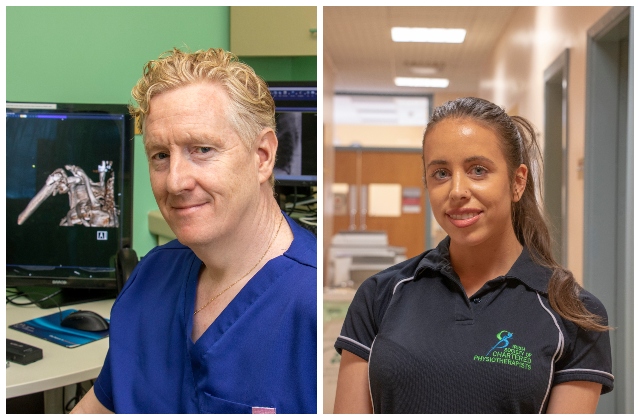![]()
You are here
Virtual Outpatient Clinics take place at Mayo University Hospital

In response to the COVID outbreak, the Orthopaedic and Physiotherapy teams at Mayo University Hospital (MUH) developed virtual clinics to assess patients with fractures who could be managed remotely. With the support of hospital management and co-operation from Radiology, Administration and Nursing staff, the special clinics have minimised hospital visits for hundreds of patients, keeping them safe at home as much as possible
Commenting Prof Paul O’Grady, Consultant Orthopaedic Surgeon at Mayo University Hospital said, “Despite the significant impact COVID-19 had on the health services over the last number of months, people are still sustaining injuries, including fractures and need to be treated and followed-up. Our emergency orthopaedic service has continued and we have seen many patients in our clinics. As we now move to restoring more of our clinics, including our follow-up clinics, we have started to use technology to support our clinic. This is particularly important for vulnerable or older patients and it allows us assess them remotely and avoids the need for them to attend the hospital. The technology we have put in place allows us view patients x-rays or CT scans remotely and then we can determine the most appropriate treatment for patients. This system also allows us speak with our patients and almost 70% of the outpatient consultations in our fracture clinic are being done remotely. When it is necessary or clinically appropriate, patients attend the clinic in person. The feedback from our patients has been really positive to date.”
In relation to the use of virtual clinics for patients of the Physiotherapy Department, Sarah Dunne, Physiotherapist said, “Over the last few months our department has been providing patients with a telehealth service. Through the use of an app we have been able to offer our patients phone and video call consultations. During these consultations we are able to accurately assess our patients, address any queries and concerns they may have, provide them with advice and implement suitable treatment plans. Telehealth has proven to be a really effective means of treatment for patients of all ages. It has allowed us to provide our patients with ongoing support and continuity of care, which has been especially welcomed by patients who are cocooning.”
Commenting Catherine Donohoe, Hospital Manager Mayo University Hospital added, “Across the hospital we are looking at different ways of using technology so we can further increase access and improve the care we provide to our patients. While there are a proportion of outpatient clinics or appointments that need to continue face to face, many can be done remotely which means the patient does not have to travel to the hospital. Over the coming months as we work to manage implementing social distancing across our services, being able to run virtual clinics or use telemedicine will be even more important. I am very grateful to the team in MUH for the effort they have put in to progress telemedicine and I am excited about expanding this in the future.”
Video link: Prof Paul O’Grady, Consultant Orthopaedic Surgeon and Sarah Dunne, Physiotherapist talk about how virtual outpatient clinics at Mayo University Hospital are being used to assess patients and implement suitable treatment plans:
https://www.youtube.com/watch?v=4yh5-NDc5Ms
or
https://twitter.com/saoltagroup/status/1278996563273056257
The article above is specific to the following Saolta hospitals::
Mayo University Hospital (MUH)
Keywords:
